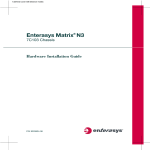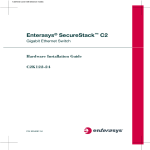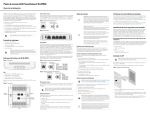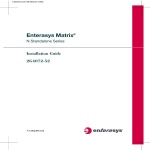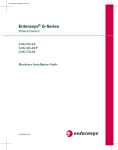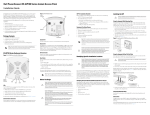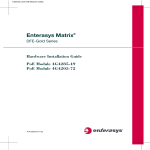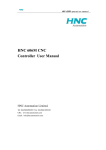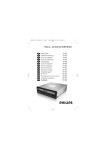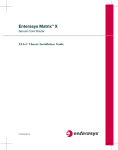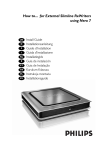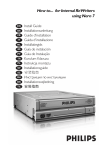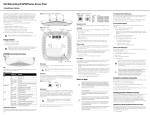Download Dell W-7200 Installation Manual
Transcript
Dell PowerConnect W-7200 Series Controller Installation Guide Copyright © 2013 Aruba Networks, Inc. Aruba Networks trademarks include , Aruba Networks®, Aruba Wireless Networks®, the registered Aruba the Mobile Edge Company logo, and Aruba Mobility Management System®. Dell™, the DELL™ logo, and PowerConnect™ are trademarks of Dell Inc. All rights reserved. Specifications in this manual are subject to change without notice. Originated in the USA. All other trademarks are the property of their respective owners. Open Source Code Certain Aruba products include Open Source software code developed by third parties, including software code subject to the GNU General Public License (GPL), GNU Lesser General Public License (LGPL), or other Open Source Licenses. Includes software from Litech Systems Design. The IF-MAP client library copyright 2011 Infoblox, Inc. All rights reserved. This product includes software developed by Lars Fenneberg, et al. The Open Source code used can be found at this site: http://www.arubanetworks.com/open_source Legal Notice The use of Aruba Networks, Inc. switching platforms and software, by all individuals or corporations, to terminate other vendors’ VPN client devices constitutes complete acceptance of liability by that individual or corporation for this action and indemnifies, in full, Aruba Networks, Inc. from any and all legal actions that might be taken against it with respect to infringement of copyright on behalf of those vendors. Dell PowerConnect W-7200 Series Controller | Installation Guide 0511259-01 | January 2013 Contents Preface.......................................................................................................................................................................5 Guide Overview................................................................................................................................... 5 Related Documentation..................................................................................................................... 5 Contacting Support ............................................................................................................................ 5 Chapter 1 Dell PowerConnect W-7200 Controller ............................................................................7 Models.................................................................................................................................................. 7 Package Checklist.............................................................................................................................. 7 Front Panel........................................................................................................................................... 8 Dual-Media Ports ....................................................................................................................... 8 10/100/1000Base-T (RJ-45) Ports ..................................................................................... 8 1000Base-X (SFP) Ports..................................................................................................... 9 Dual-Media Port LEDs ....................................................................................................... 9 10GBase-X (SFP+) Ports.......................................................................................................... 10 10GBase-X Port LEDs ...................................................................................................... 10 Management/Status LED Indicators ..................................................................................... 11 LCD Panel................................................................................................................................... 11 Disabling the LCD Screen ............................................................................................... 13 Mini USB Console Connector................................................................................................. 14 Mini USB Driver................................................................................................................ 14 Console Port .............................................................................................................................. 14 Serial Console Port Adaptor........................................................................................... 15 USB Interface............................................................................................................................ 15 Expansion Slot........................................................................................................................... 15 Rear Panel ......................................................................................................................................... 15 Fan Tray...................................................................................................................................... 16 Hot Swapping.................................................................................................................... 16 Power Supply ............................................................................................................................ 17 Load Sharing ..................................................................................................................... 17 Redundancy ...................................................................................................................... 17 Hot Swapping.................................................................................................................... 17 Modules ............................................................................................................................. 18 LEDs.................................................................................................................................... 18 Chapter 2 Installation ..........................................................................................................................21 Precautions ....................................................................................................................................... 21 Selecting a Location ........................................................................................................................ 22 Two-Point Rack Mounting .............................................................................................................. 22 Required Tools and Equipment .............................................................................................. 22 Installation Steps...................................................................................................................... 22 Table or Shelf Installation ............................................................................................................... 24 Required Tools and Equipment .............................................................................................. 24 Installation Steps...................................................................................................................... 24 Connecting the AC Power Cord ..................................................................................................... 24 Installing and Removing a Fan Tray .............................................................................................. 24 Installing and Removing a Power Supply..................................................................................... 26 Installing a Power Supply ....................................................................................................... 26 Dell PowerConnect W-7200 Series Controller | Installation Guide | 3 Removing a Power Supply ...................................................................................................... 27 Installing an SFP ............................................................................................................................... 27 Removing an SFP...................................................................................................................... 27 Connecting an LC Fiber Optic Cable...................................................................................... 27 Chapter 3 Specifications, Safety, and Compliance ........................................................................29 W-7200 Controller Specifications .................................................................................................. 29 Physical...................................................................................................................................... 29 Power Supply Specifications ................................................................................................. 29 Operating Specifications ........................................................................................................ 29 Storage Specifications ............................................................................................................ 29 Safety and Regulatory Compliance ............................................................................................... 29 Regulatory Models ................................................................................................................... 30 FCC .............................................................................................................................................. 30 Industry Canada........................................................................................................................ 30 EU Regulatory Conformance .................................................................................................. 31 Battery Statements .................................................................................................................. 31 Proper Disposal of Dell Equipment................................................................................................ 31 Waste of Electrical and Electronic Equipment.................................................................... 31 European Union RoHS ............................................................................................................. 31 China RoHS................................................................................................................................ 32 4 | Dell PowerConnect W-7200 Series Controller | Installation Guide Preface This document describes the hardware features of the Dell PowerConnect W-7200 Series Controller. It provides a detailed overview of the physical and performance characteristics of each controller model and explains how to install the controller and its accessories. Guide Overview Chapter 1, “Dell PowerConnect W-7200 Controller” on page 7 provides a detailed hardware overview of the W-7200 controller and each of its components. Chapter 2, “Installation” on page 21 describes how to install the W-7200 in a number of ways and how to install each its components. Chapter 3, “Specifications, Safety, and Compliance” on page 29 lists the W-7200’s technical specifications and safety and regulatory compliance information. Related Documentation The following documents are referred to in this guide and are considered components of the complete documentation set needed for successful installation and management of a Dell W-7200 controller: Dell PowerConnect W-Series ArubaOS 6.2 User Guide Dell PowerConnect W-Series ArubaOS 6.2 Command Line Interface Reference Guide Dell PowerConnect W-Series ArubaOS 6.2 Quick Start Guide The latest documentation and this document translated into other languages can be found at dell.com/support/manuals. Contacting Support Table 1 Support Information Web Site Support Main Site dell.com Support Site dell.com/support Documentation Site dell.com/support/manuals Dell PowerConnect W-7200 Series Controller | Installation Guide Preface | 5 This page is intentionally left blank. 6 | Preface Dell PowerConnect W-7200 Series Controller | Installation Guide Chapter 1 Dell PowerConnect W-7200 Controller The Dell PowerConnect W-7200 series of controllers consists of three enterprise-class, wireless LAN controllers. These controllers connect, control, and intelligently integrate wireless Access Points (APs) and Air Monitors (AMs) into a wired LAN system. Models The Dell PowerConnect W-7200 series controller includes three models that provide varying levels of functionality. Table 2 Dell PowerConnect W-7200 Controller Model Number of APs Supported W-7210 512 W-7220 1024 W-7240 2048 Package Checklist Inform your supplier if there are any incorrect, missing, or damaged parts. If possible, retain the carton, including the original packing materials (see Table 3). Use these materials to repack and return the unit to the supplier if needed. Table 3 Package Contents Item Quantity Dell PowerConnect W-7200 Series Controller 1 Power Supply Unit - Installed 1 Fan Tray - Installed 1 Expansion Slot Cover - Installed 1 Blank Panel over unpopulated PSU Intake - Installed 1 Rack Mounting Brackets 2 M6 x 15mm Rack Mounting Screws 4 M4 x 6mm Rack Mount Bracket Screws 8 USB Console Cable 1 Power Cable 1 Dell PowerConnect W-7200 Series Installation Guide (Printed) 1 End User License Agreement (Printed) 1 Dell Document Pointer (Printed) 1 Dell PowerConnect W-7200 Series Controller | Installation Guide Dell PowerConnect W-7200 Controller | 7 NOTE: Optional accessories are available for use with the Dell PowerConnect W-7200 Series and are sold separately. Contact your Dell sales representative for details and assistance. Front Panel The front panel of the W-7200 mobility controller contains the following components: Four 10GBase-X (SFP+) ports Two Dual-Media Ports LINK/ACT and Status LEDs Management/Status LED LCD Panel and Navigation Buttons Console Connections - RJ-45 and Mini-USB Expansion Slot (reserved for future use) Figure 1 Front Panel of the W-7200 Dual-Media Ports The W-7200 is equipped with 2 sets of dual-media ports (ports 0 and 1). These ports can utilize either the 1000Base-X or 10/100/1000Base-T connections provided. However, the 1000Base-X fiber connection has priority over the 10/100/1000Base-T copper connection. If a link is detected on the 1000Base-X interface, the 10/100/ 1000Base-T connection will be disabled. NOTE: Dell tests and supports optics offered through Dell W-Series products within Dell controller systems. Third party optics are not tested or supported; therefore, Dell does not guarantee proper functionality of third party optics when used in a Dell controller. 10/100/1000Base-T (RJ-45) Ports The W-7200 controller is equipped with two 10/100/1000Base-T copper ports. Gigabit Ethernet uses all eight wires and each pair is used in a bi-directional fashion, meaning the same pairs are used for both data transmission and reception. Figure 2 illustrates the CAT-5 pin-out found on an RJ-45 connector. The CAT-5 pin-out pairs the following pins on a 10/100/1000Base-T Gigabit Ethernet port: 1/2, 3/6, 4/5, and 7/8. 8 | Dell PowerConnect W-7200 Controller Dell PowerConnect W-7200 Series Controller | Installation Guide Figure 2 10/100/1000Base-T Management Port Pin Out 1000Base-T Gigabit Ethernet Port RJ-45 Female Pin-Out 1 2 3 4 5 6 7 8 Signal Name Function BI_DA+ BI_DABI_DB+ BI_DC+ BI_DCBI_DBBI_DD+ BI_DD- Bi-directional pair +A Bi-directional pair -A Bi-directional pair +B Bi-directional pair +C Bi-directional pair -C Bi-directional pair -B Bi-directional pair +D Bi-directional pair -D 1000Base-X (SFP) Ports The W-7200 controller is equipped with two 1000Base-X combination ports for fiber connectivity only and are intended for use with Dell SFPs (mini-GBICs). NOTE: Dell tests and supports optics offered through Dell W-Series products within Dell controller systems. Third party optics are not tested or supported; therefore, Dell does not guarantee proper functionality of third party optics when used in a Dell controller. Dual-Media Port LEDs Each pair of Dual-Media ports is equipped two LEDs that allow you to monitor the status of and activity on the port. These LEDs provide basic monitoring of the status, activity, and basic configuration of each port. The information displayed by these LEDs can be changed via the LCD. LINK/ACT: on the left side of the port, displays the link status of the port. Status: on the right side of the port, displays the status of the port. The information displayed by this LED changes based on LCD’s mode. The LED behavior for each mode is described in Table 4 and Table 5. Table 4 10/100/1000Base-T Port LEDs LED Function LCD Mode Indicator Status LINK/ACT Link status N/A Green (Solid) Link has been established Green (Blinking) Port is transmitting or receiving data Off No link Green (Solid) Port Enabled Off Port Administratively Disabled Green (Solid) Full-duplex Off Half-duplex Green (Solid) 1000 Mbps Off 10/100 Mbps Status Port status Administrative Duplex Speed Dell PowerConnect W-7200 Series Controller | Installation Guide Dell PowerConnect W-7200 Controller | 9 Table 5 1000Base-X Port LEDs LED Function LCD Mode Indicator Status LINK/ACT Link status N/A Green (Solid) Link has been established Green (Blinking) Port is transmitting or receiving data Off No link Green (Solid) Port Enabled Off Port Administratively Disabled Green (Solid) Full-duplex Off Half-duplex Green (Solid) 1 Gbps Off Speed mismatch Status Port status Administrative Duplex Speed 10GBase-X (SFP+) Ports The W-7200 is equipped with 4 10GBase-X (SFP+) ports. These port are labeled as 2, 3, 4, and 5. These ports are intended for use with Dell SFPs. SFPs are 10Gb hot-swappable, optical transceivers, which convert serial electrical signals to external serial optical or electrical signals. The ports support dual speed (1GbE or 10GbE) operation. NOTE: Dell tests and supports optics offered through Dell W-Series products within Dell controller systems. Third party optics are not tested or supported; therefore, Dell does not guarantee proper functionality of third party optics when used in a Dell controller. 10GBase-X Port LEDs Each 10GBase-X port is equipped two LEDs that allow you to monitor the status of and activity on the port. These LEDs provide basic monitoring of the status, activity, and basic configuration of each port. The information displayed by these LEDs can be changed via the LCD. LINK/ACT: on the left side of the port, displays the link status of the port. Status: on the right side of the port, displays the status of the port. The information displayed by this LED changes based on LCD’s mode. The LED behavior for each mode is described in Table 6. Table 6 10GBase-X Port LEDs LED Function LCD Mode Indicator Status LINK/ACT Link status N/A Green (Solid) Link has been established Green (Blinking) Port is transmitting or receiving data Off No link 10 | Dell PowerConnect W-7200 Controller Dell PowerConnect W-7200 Series Controller | Installation Guide Table 6 10GBase-X Port LEDs LED Function LCD Mode Indicator Status Status Port status Administrative Green (Solid) Port Enabled Off Port Administratively Disabled Green (Solid) Full-duplex Off Half-duplex Green (Solid) 10 Gbps Off Speed mismatch Duplex Speed Management/Status LED Indicators In addition to the LEDs on each individual port, there are three additional LEDs on the front panel that provide overall status of the device. These LEDs provide basic monitoring of the overall status of the W-7200 controller. Table 7 Management/Status LEDs LED Function Indicator Status Power Input power status/ system status Green (Solid) Power On Off Power Off Module status Green (Solid) Operational Green (Blinking) Device is loading software (on initial start only) Amber (Blinking) Major Alarm Amber (Solid) Critical Alarm Off No power N/A N/A Status Peered Reserved for future use LCD Panel The W-7200 controller is equipped with an LCD panel that displays a variety of information about the controller’s status and provides a menu that allows for basic operations such as initial setup and reboot. The LCD panel displays two lines of text with a maximum of 16 characters on each line. When using the LCD panel, the active line is indicated by an arrow next to the first letter. Dell PowerConnect W-7200 Series Controller | Installation Guide Dell PowerConnect W-7200 Controller | 11 Figure 3 LCD Panel 1 MENU R ENTE ER POW US STAT 2 3 ED PEER 7200_03 OLE CONS Table 8 LCD Panel Components Callout Component Description 1 LCD Screen Used to configure LCD behavior and other basic operations 2 Menu Button Used to select the LCD screen menu 3 Enter Button Used to execute actions on the LCD Screen The LCD panel is operated using the two navigation buttons to the left of the screen. Menu: Allows you to navigate through the menus of the LCD panel. Enter: Confirms and executes the action currently displayed on the LCD panel. The LCD has four modes: Boot: Displays the boot up status. LED Mode: Displays the mode that the STATUS LED is in. Status: Displays the status of different components of the W-7200 controller, including Power Supplies and ArubaOS version. Maintenance: Allows you to execute some basic operations of the W-7200 controller such as uploading an image or rebooting the system. Table 9 LCD Panel Mode: Boot Function/Menu Options Displays Displays boot status “Booting Dell PowerConnect W-ArubaOS... The LED mode menu allows you to choose what information is communicated by the LEDs on each port. Refer to Table 6 on page 10 for descriptions of the LED behavior of each mode. Table 10 LCD Panel Mode: LED Mode Function/Menu Options Displays Administrative LED MODE: ADM - displays whether the port is administratively enabled or disabled. Duplex LED MODE: DPX - displays the duplex mode of the port. 12 | Dell PowerConnect W-7200 Controller Dell PowerConnect W-7200 Series Controller | Installation Guide Table 10 LCD Panel Mode: LED Mode Function/Menu Options Displays Speed LED MODE: SPD - displays the speed of the port. Exit Idle Mode EXIT IDLE MENU Table 11 LCD Panel Mode: Status Function/Menu Options Displays ArubaOS Version ArubaOS X.X.X.X PSU Status Displays status of the power supply unit. PSU 0: [OK | FAILED | MISSING] PSU 1: [OK | FAILED | MISSING] Fan Tray Displays fan tray status. FAN STATUS: [OK | ERROR | MISSING] FAN TEMP: [OK | HIGH | SHUTDOWN] Exit Status Menu EXIT STATUS Table 12 LCD Panel Mode: Maintenance Function/Menu Options Displays Upgrade Image Upgrade the software image on the selected partition from a predefined location on the attached USB flash device. Partition [0 | 1] Upgrade Image [no | yes] Upload Config Uploads the controller’s current configuration to a predefined location on the attached USB flash device. Upload Config [no | yes] Erase Config Allows you to erase the current configuration. Erase Config [no | yes] Factory Default Allows you to return the controller to the factory default settings. Factory Default [no | yes] Media Eject Completes the reading or writing of the attached USB device. Media Eject [no | yes] System Reboot Allows you to reboot the controller. Reboot [no | yes] System Halt Allows you to halt the controller. Halt [no | yes] Exit Maintenance Menu EXIT MAINTENANCE Disabling the LCD Screen By default, the LCD screen is enabled. However, if your W-7200 controller is deployed in a location without physical security, the LCD screen can be disabled through the CLI. When disabled, pushing one of the navigation buttons will only illuminate the screen and display the slot, role, device name, and any alarms. Additionally, it is possible to only disable the maintenance menu. This allows you to change the LED behavior and view the device status but prevents upgrades and configuration changes. Dell PowerConnect W-7200 Series Controller | Installation Guide Dell PowerConnect W-7200 Controller | 13 To disable the LCD screen, enter the Enable mode and use the following CLI commands: (host) #configure terminal (host) (config) #lcd-menu (host) (lcd-menu) #disable menu To disable only the Maintenance menu or one of its sub-menus, enter the Enable mode and use the following CLI commands: (host) #configure terminal (host) (config) #lcd (host) (lcd-menu) #disable menu maintenance ? factory-default halt-system media-eject reload-system upgrade-image upload-config (host) (lcd-menu) #disable menu maintenance upgrade-image ? partition0 partition1 Mini USB Console Connector The W-7200 controller is equipped with one Mini USB (mini type B) connector that provides console access for direct local access. If you are connected using the Mini USB connector and the RJ-45 Console Port, the Mini USB connection will take priority. Mini USB Driver To use the Mini USB console port, you must install the Dell USB console driver on the computer that will manage your W-7200 controller. Drivers are available for download at download.dell-pcw.com. Console Port A serial console port is provided for connection to a terminal, allowing for direct local management. The port’s RJ-45 female connector accepts an RS-232 serial cable with a male connector. Figure 4 Serial Console Port Pin-Out Serial Console Port RJ-45 Female Pin-Out 1 2 3 4 5 6 7 8 Direction Input Output TxD GND GND RxD Communication settings for the serial console port are indicated in Table 13. Table 13 Console Terminal Settings Baud Rate Data Bits Parity Stop Bits Flow Control 9600 8 None 1 None CAUTION: Do not connect an Access Point (AP) to the serial console port. The serial console port is compatible with only RS-232 devices. Non-RS-232 devices, such as APs, are not supported. 14 | Dell PowerConnect W-7200 Controller Dell PowerConnect W-7200 Series Controller | Installation Guide Serial Console Port Adaptor A modular adaptor can be used to convert the RJ-45 (female) connector to a DB9 (male) connector. Refer to Figure 5 for complete details. Figure 5 RJ-45 (female) to DB9 (male) Modular Adaptor Conversion RJ-45 Female Pin-Out 1 2 3 TxD 4 5 GND 6 RxD 7 8 Internal Connections RJ-45 TxD 3 4 5 GND RxD 6 DB-9 Male Pin-Out DB-9 2 5 3 5 4 3 2 1 9 8 7 6 Ground RxD TxD USB Interface The W-7200 controller is equipped with one USB 2.0 interface. A USB storage device can be used to save and upload configurations to the controller. USB functions are controlled through the LCD panel on the front of the controller. For more information on the LCD panel and its functions, see “LCD Panel” on page 11. Expansion Slot The expansion slot is reserved for future use. Rear Panel The rear panel of the W-7200 controller consists of the following components: Two power supply slots One fan tray slot Grounding point 7200_02 Figure 6 Rear Panel Dell PowerConnect W-7200 Series Controller | Installation Guide Dell PowerConnect W-7200 Controller | 15 Fan Tray CAUTION: The W-7200 controller is equipped with a field-replaceable, hot-swappable fan tray. Each fan tray features four individual fans that pull air through the chassis from the front through to the rear. Each fan tray can tolerate the failure of a single fan while maintaining a safe operating temperature for the controller CAUTION: The W-7200 controller is not compatible with fan trays from other Dell hardware platforms. Hot Swapping Hot swapping allows you to replace a failed fan tray, making it unnecessary to shut down the W-7200 controller during the replacement procedure. Figure 7 Fan Tray 2 3 1 Table 14 Fan Tray Components Callout Component Description 1 Left Latch Used to secure the left side of the fan tray to the chassis. 2 Right Latch Used to secure the right side of the fan tray to the chassis. 3 Handle Used to insert and remove the fan tray from the chassis. Figure 8 shows the airflow pattern for the W-7200 controller. The blue arrows show cool air being pulled into the device and the red arrows show warm air being forced out by the fan tray module. When installing your W-7200 controller, ensure that you leave sufficient space around the device for proper airflow. 16 | Dell PowerConnect W-7200 Controller Dell PowerConnect W-7200 Series Controller | Installation Guide Figure 8 Air Flow Pattern Power Supply CAUTION: Never insert or remove a power supply while the power cord is connected. Verify that cord has been disconnected from the power supply before installation or removal. The W-7200 series controller’s Power Supply adapts electrical power for use with the W-7200. The chassis has two slots that can hold individual power supplies to support load sharing, redundancy, and fault tolerance. The W-7200 controller comes equipped with a single 350W AC power supply. The W-7200 controller is shipped with one hot-swappable, field-replaceable, AC power supply and one blank face plate. The included power supply is installed in the slot PSU 0, while slot PSU 1 has a blank face plate covering the opening. The controller can operate with one or two active power supplies, depending on the demands of your configuration. Load Sharing Load sharing occurs when more than one power supply of the same rating is installed in the W-7200 controller and turned on. Load sharing divides the total power load of the controller among all available power supplies. Since the power supplies work together, the effective power capacity of the controller is increased with each additional power supply. Redundancy With power redundancy, the W-7200 controller can continue normal operation even when a power supply fails or is turned off. When multiple power supplies are installed, if one becomes unavailable (fails, or is turned off or removed) the remaining power supplies will attempt to provide full power for the device. If the device’s total power load does not exceed the combined rated output of the remaining, operational power supplies, the controller will continue to operate. Hot Swapping Hot swapping allows you to replace one failed power supply while the others provide full power. This makes it unnecessary to shut down the W-7200 controller during the replacement procedure. Hot swapping is supported only when power redundancy is in effect. This requires that after the target power supply is removed, the device’s total power load does not exceed the combined rated output of the remaining power supplies Dell PowerConnect W-7200 Series Controller | Installation Guide Dell PowerConnect W-7200 Controller | 17 Modules The 350W power supply is an autosensing, load-sharing, redundant power supply module that supports an input voltage of 100 VAC to 240 VAC. Each power supply has a country-specific power cord for connection to an AC power outlet. Figure 9 Power Supply (AC Power Supply Shown) 1 2 3 7200_06 4 7 8 5 6 Table 15 Power Supply Components Callout Component Description 1 Latch Used to secure the power supply to the chassis. 2 AC LED AC status LED. 3 DC LED DC status LED. 4 TEMP LED Power supply temperature LED. 5 Retaining Clip Secures the power cord to the power supply. 6 AC Power Cable Socket Attach power cord here. 7 Handle Used to insert and remove the power supply from the chassis. 8 Power Supply Blanking Plate Covers the extra power supply slot. Do not operate your W-7200 controller without this blanking plate or a power supply in either slot. LEDs Each power supply is equipped with three LEDs to help monitor the power supply module’s status. Table 16 Power Supply Module LEDs LED Description Indicator Status AC AC Status Green (Solid) Operating Normally AC voltage is OK. Red (Solid) Power Supply Failure 18 | Dell PowerConnect W-7200 Controller Dell PowerConnect W-7200 Series Controller | Installation Guide Table 16 Power Supply Module LEDs LED Description Indicator Status DC DC Status Green (Solid) Operating Normally Red (Solid) Power Supply Failure Green (Solid) Operating Normally Red (Solid) Power Supply Failure TEMP Power Supply Temperature Dell PowerConnect W-7200 Series Controller | Installation Guide Dell PowerConnect W-7200 Controller | 19 This page is intentionally left blank. 20 | Dell PowerConnect W-7200 Controller Dell PowerConnect W-7200 Series Controller | Installation Guide Chapter 2 Installation CAUTION: Installation of the device should be performed by a trained installation professional. This chapter describes how to install a Dell PowerConnect W-7200 controller using the many mounting options available. The W-7200 controller ships with an accessory kit that includes the equipment needed to install the controller in standard, two-point 19-inch telco rack. Additional mounting options are sold separately. “Precautions” on page 21 “Selecting a Location” on page 22 “Two-Point Rack Mounting” on page 22 “Table or Shelf Installation” on page 24 “Connecting the AC Power Cord” on page 24 “Installing and Removing a Fan Tray” on page 24 “Installing and Removing a Power Supply” on page 26 CAUTION: Please only use included or Dell specified cables, power cords, AC power supplies and batteries. The power cord should not be used with other electric equipment than what is specified by Dell. CAUTION: AC Precautions Ensure that the rack is correctly and securely installed to prevent from falling or becoming unstable. Dangerous voltage in excess of 240VAC is always present while the Dell Power Supply Module is plugged into an electrical outlet. Remove all rings, jewelry, and other potentially conductive material before working with this product. Never insert foreign objects into the chassis, the power supply, or any other component, even when the power supplies have been turned off, unplugged, or removed. Main power is fully disconnected from the W-7200 controller by unplugging all installed power supplies’ power cords from their outlets. For safety, verify the power outlets and plugs are in easy reach of the operator. Do not handle electrical cables which are not insulated. This includes any network cables. To minimize electrical hazard, keep water and other fluids away from the product. Comply with electrical grounding standards during all phases of installation and operation of the product. Do not allow the W-7200 chassis, network ports, power supplies, or mounting brackets to contact any device, cable, object, or person attached to a different electrical ground. Also, never connect the device to external storm grounding sources. Installation or removal of the chassis or any module must be performed in a static-free environment. The proper use of anti-static body straps and mats is strongly recommended. Dell PowerConnect W-7200 Series Controller | Installation Guide Installation | 21 Modules must be kept in anti-static packaging when not installed in the chassis. Do not ship/store this product near strong electro-magnetic, electrostatic, magnetic or radioactive fields. Do not disassemble the chassis or any module. Selecting a Location The W-7200 controller, like other network and computing devices, requires an “electronics friendly” environment. Reliable power. Verify that your electrical outlet is compatible with the W-7200 power supplies. Cool, non-condensing ventilation For proper operation, the W-7200 requires an environment with an ambient air temperature between 0 and 40 ºC (32 to 104 ºF). Humidity must be kept at non-condensing levels between 5 and 95%. Where a large number of electrical devices are working in the same area, additional air conditioning or air circulation equipment may be required. Ample space For proper air circulation, leave at least 10 cm (4 inches) clearance for the vents on the left, right, front, and rear of the chassis. Leave additional space in front of the chassis to access power cords, network cables, and indicator LEDs. Limited electromagnetic interference For best operation, keep the W-7200 controller and all cords and cables at least 0.7 meters (2 feet) from fluorescent lighting fixtures, and 2 meters (6 feet) from photocopiers, radio transmitters, electric generators, and other sources of strong electromagnetic interference. Two-Point Rack Mounting The included two-point rack mounting kit provides the necessary hardware to securely mount a W-7200 controller in standard 19” telco rack. CAUTION: Each W-7200 controller should have its own mounting equipment. Do not place other networking equipment directly on top a mounted W-7200 controller. Failure to do so can result in damage to the device. Required Tools and Equipment The following tools and equipment are required for installation of a W-7200 controller: Rack mount bracket (x2, not used for tabletop installation) M4 x 6mm Phillips flat head screws (8x, included with rack mount brackets) M6 x 15mm Phillips flat head screws (4x, 19-inch (48.26 cm) rack system mount screws) Suitable screwdrivers for both screw types NOTE: Some racks require screws that differ from those included with the W-7200 controller. Confirm that you have the correct screws before installing your W-7200 controller. Installation Steps To install a W-7200 controller into a two-point 19-inch (48.26 cm) rack system: 1. Place a rack mount bracket over the mounting holes on one side of the controller (see Figure 10). 2. Secure the bracket to the controller using four M4 x 6mm phillips flat head screws and a suitable screwdriver. 22 | Installation Dell PowerConnect W-7200 Series Controller | Installation Guide 3. Repeat these steps on the opposite side of the controller. 7200_08 Figure 10 Rack Mount Brackets 4. Mount the controller within your organization’s rack system using four (two per bracket) M6 x 15mm phillips flat head screws and suitable screwdriver (see Figure 11). 7200_08a Figure 11 Rack Mount Installation 5. Leave a minimum of four inches (10cm) of space on the left and right side of the unit for proper air flow and ventilation. See Figure 8 on page 17 for more information about the W-7200’s airflow requirements. Dell PowerConnect W-7200 Series Controller | Installation Guide Installation | 23 6. Leave additional space in front and back of the unit to access power cords, network cables, the LCD panel, and LED status indicators Table or Shelf Installation Required Tools and Equipment Rubber Feet (included) Installation Steps 1. Attach the included rubber feet to the bottom of the controller. 2. Place your controller in the location you have chosen. 3. Connect the AC power cord to the rear of the unit. 4. Plug the opposite end of the power cord into an electrical outlet to power the controller. Connecting the AC Power Cord Once you have installed the W-7200 controller, you are ready to power on the device. The W-7200 controller is not equipped with an On/Off switch. The device will turn on when the AC power cord has been connected to the power supply module and an AC power outlet. To connect the AC power cord: 1. Ensure that the power supply module is correctly installed in the W-7200 controller. 2. Lift the power cord retaining clip so it is not blocking the AC power connector. 3. Insert the coupler end of the AC power cord into the AC power connector on the power supply module. 4. Lower the power cord retaining clip over the AC power cord. The W-7200 controller should now be receiving power. Since the W-7200 controller does not have an On/Off switch, you must use the power cord to turn the device on or off. To turn the device off: 1. Lift the power cord retaining clip off the AC power cord. 2. Pull the AC power cord from the power supply module. Installing and Removing a Fan Tray NOTE: Use standard ESD precautions when installing or removing a fan tray module. The fan tray is field-replaceable and hot-swappable. Hot-swapping allows you to replace the fan tray without having to power down the W-7200 controller. 1. Remove the old fan tray. a. Using a Phillips Head screwdriver, turn the hinged captive screws counter-clockwise until loose (they cannot be removed completely). b. Firmly grasp both of the hinged captive screws and pull the spring loaded hinge down until you are sure the hinges are disengaged. Use the fan tray handle to pull the fan out. 24 | Installation Dell PowerConnect W-7200 Series Controller | Installation Guide 2. Align the new fan tray module with opening in the controller, as shown in Figure 12. CAUTION: Ensure that fan tray module is correctly aligned with the opening on the W-7200. Failure to do so can result in damage to the fan tray module. 3. Pull down the hinged captive screws on the new fan tray module and align its tabs with the slots on either side of the opening. 4. Slide the fan tray module into the controller. 5. Lift both the hinged captive screws into the lock position then secure the fan tray module by tightening the captive screws. Figure 12 Installing a Fan Tray Dell PowerConnect W-7200 Series Controller | Installation Guide Installation | 25 Installing and Removing a Power Supply CAUTION: Never insert or remove a power supply while the power cord is connected. Verify that cord has been disconnected from the power supply before installation or removal. NOTE: Use standard ESD precautions when installing or removing a power supply module. The power supply modules are hot-swappable. Hot swapping allows you to replace a failed power supply without powering down the W-7200 controller during the replacement process. This makes it unnecessary to shut down the W-7200 controller during the replacement procedure. Installing a Power Supply NOTE: If you are adding an additional power supply module, remove the pre-installed power supply module blanking plate and follow the instructions below. If you are replacing a failed power supply, see “Removing a Power Supply” on page 27 before you continue. 1. With a Phillips Head screwdriver, turn the hinged captive screw counter-clockwise until it is loose (they cannot be completely removed). 2. Firmly grasp both of the hinged captive screws and pull the spring loaded hinge down until you are sure the hinges are disengaged. 3. Grasp the power supply blanking plate by the hinged captive screw and slide the plate out. 4. Align the new power supply module with opening in the controller, as shown in Figure 13. 5. Pull down the hinged captive screw on the power supply module and align its tab with the slot on the left side of the opening. 6. Slide the power supply module into the controller. 7. Lift the hinged captive screw and secure the power supply module by tightening the screw with a Phillips Head screwdriver. Take care not to over-tighten the screw. 7200_07 Figure 13 Installing a Power Supply 8. Insert the power cord and secure it by lowering the power cord retaining clip over the power cord. 26 | Installation Dell PowerConnect W-7200 Series Controller | Installation Guide Removing a Power Supply To remove a power supply from your W-7200 controller: 1. Lift the power cord retaining clip from the power cord. 2. Remove the power cable connected to the power supply module. 3. Using a Phillips head screwdriver, loosen the hinged captive screw on the front of the power supply module. 4. Lower the hinged captive screw as far as it can go. 5. Using the power supply module’s handle, pull the module out. 6. If you are not replacing the removed power supply module, install a blanking plate that was included with your W-7200 controller by following the installation procedure under “Installing a Power Supply” on page 26. Installing an SFP NOTE: Use standard ESD precautions when installing or removing an SFP. To install an SFP module into the W-7200 controller: 1. Slide the SFP module, top side facing upward, into a 1000Base-X port until a connection is made and an audible click is heard. See Figure 14 for more information. 7200_09 Figure 14 Installing an SFP Removing an SFP To remove an SFP module: 1. Open and release the latch on the SFP module. 2. Pull and remove the module from the port. Connecting an LC Fiber Optic Cable To connect an LC fiber optic cable into an SFP-SX or SFP-LX module: 1. Clean the fiber optic cable connector before inserting it into the SFP module. Dell PowerConnect W-7200 Series Controller | Installation Guide Installation | 27 2. Insert the fiber optic cable into the SFP module. Ensure that the latch on the cable faces the top of the SFP module. 3. Slide the cable into place until a connection is made and an audible click is heard. To disconnect an LC fiber optic cable from an SFP-SX or SFP-LX module: 1. Depress the transceiver handle to release the latch on the cable and simultaneously pull the cable out of the port. Corvina_16 Figure 15 Connecting an LC Fiber Optic Cable 28 | Installation Dell PowerConnect W-7200 Series Controller | Installation Guide Chapter 3 Specifications, Safety, and Compliance W-7200 Controller Specifications Physical Device Dimensions (without mounting brackets) (HxWxD) All Models: 1.75” x 17.5” x 17.5” All Models: 4.4 cm x 44.5 cm x 44.5 cm Device Weight (with one AC power supply installed) All Models: 16.43 lbs (7.45 kg) Power Supply Specifications 350W AC Power Supply AC Input Voltage: 100 VAC to 240 VAC AC Input Current: 5-2.5A AC Input Frequency: 50 - 60 Hz Weight: 2.8 lbs (1.3 kg) Operating Specifications Operating Temperature Range: 0°C to 40°C (32°F to 104°F) Operating Humidity Range: 5% to 95% (RH), non-condensing Storage Specifications Storage Temperature Range: 0°C to 50°C (32°F to 122°F) Storage Humidity Range: 5% - 95% (RH), non-condensing Safety and Regulatory Compliance Dell provides a multi-language document that contains country-specific restrictions and additional safety and regulatory information for all Dell hardware products. The Dell PowerConnect W-Series Safety, Environmental, and Regulatory Information document is included with this product. CAUTION: Dell controllers must be installed by a professional installer. The professional installer is responsible for ensuring that grounding is available and it meets applicable local and national electrical codes. Dell PowerConnect W-7200 Series Controller | Installation Guide Specifications, Safety, and Compliance | 29 Regulatory Models This document covers the following models: Table 17 Regulatory Model Numbers Part Number Regulatory Model Number W-7210 W-7210-IL ARCN0100 W-7210-US W-7220 W-7220-IL ARCN0101 W-7220-US W-7240 W-7240-IL ARCN0102 W-7240-US FCC This device complies with Part 15 of the FCC Rules. Operation is subject to the following two conditions: 1. this device may not cause harmful interference 2. this device must accept any interference received, including interference that may cause undesired operation. Industry Canada This Class A digital apparatus complies with Canadian ICES-3 & Cet appareil numérique de la classe A est conforme à la norme NMB-3 du Canada. 30 | Specifications, Safety, and Compliance Dell PowerConnect W-7200 Series Controller | Installation Guide EU Regulatory Conformance This product is CE marked according to the provisions of the EMC Directive (2004/108/EC) - CE. Dell, hereby declares that 7210; 7220 & 7240 device models are in compliance with the essential requirements and other relevant provisions of Directive (2004/108/EC). CE The Declaration of Conformity made under Directive 1999/5/EC is available for viewing at the following location in the EU community. CLASS 1 LASER PRODUCT CAUTION: Use of controls or adjustments of performance or procedures other than those specified in this manual may result in hazardous radiation exposure. This product complies with 21 CFR Chapter 1, Subchapter J, Part 1040.10, and IEC 60825-1: 1993, A1: 1997, A2: 2001, IEC 60825-2:2000-05. For continued compliance with the above laser safety standards, only approved Class 1 modules from our approved vendors should be installed in the product. Battery Statements CAUTION: Il y a danger d’explosion s’il y a remplacement incorrect de la batterie. Remplacer uniquement avec une batterie due même type ou d’un équivalent recommandé par le constructeur. Mettre au rebut les batteries usagées conformément aux unstruction du fabricant. CAUTION: The battery supplied with this product may contain perchlorate material. Special handling may apply in California and other certain states. See www.dtsc.ca.gov/hazardouswaste/perchlorate for more information. WARNING: Risk of explosion if battery is replaced by an incorrect type. Dispose of used batteries according to the instructions. Proper Disposal of Dell Equipment Waste of Electrical and Electronic Equipment Dell products at end of life are subject to separate collection and treatment in the EU Member States, Norway, and Switzerland and therefore are marked with the symbol shown at the left (crossed-out wheelie bin). The treatment applied at end of life of these products in these countries shall comply with the applicable national laws of countries implementing Directive 2002/96EC on Waste of Electrical and Electronic Equipment (WEEE). European Union RoHS Dell products also comply with the EU Restriction of Hazardous Substances Directive 2011/65/EC (RoHS). Dell PowerConnect W-7200 Series Controller | Installation Guide Specifications, Safety, and Compliance | 31 China RoHS Dell products also comply with China environmental declaration requirements and are labeled with the “EFUP 50” label shown at the left. Ქኂ‛䋼ჿ Hazardous Materials Declaration ㇱઙฬ⒓ (Parts) Ქኂ‛䋼 ᚗర⚛Hazardous Substances) ચ䫀 ᄙ⒈ 㘨 ⧶ 䬝 Chromium VI Polybrominated Cadmium Compounds Biphenyls (Cd) 6+ (Cr ) (PBB) ᄙ⒈ ੑ⧶䝮 Polybrominated Diphenyl Ether (PBDE) Lead (Pb) ᳮ Mercury (Hg) ⬉ 〝᧼ PCA Board X O O O O O ᪾㒘 ઙ Mechanical Subassembly X O O O O O ⬉ Ḯㅎ㈩ེ Power Adaptor X O O O O O 䪙 O:␜䆹 Ქኂ‛䋼 䆹 ㇱઙᚲဋ䋼 ᧚ᢱਛ⊛㊂ဋSJ/T11363-2006ᷛ ಎ㾘 ቯ⊛㒢㊂ⷐ᳞એਅޕ This component does not contain this hazardous substance above the maximum concentration values in homogeneous materials specified in the SJ/T11363-2006 Industry Standard. X: ␜䆹 Ქኂ‛䋼 ⥋ዋ䆹 ㇱઙ⊛ᨱ৻ဋ䋼 ᧚ᢱਛ⊛㊂SJ/T11363-2006ᷛ ಎ㾘 ቯ⊛㒢㊂ⷐ᳞ޕ This component does contain this hazardous substance above the maximum concentration values in homogeneous materials specified in the SJ/T11363-2006 Industry Standard. ᇍ䫔ଂП᮹ⱘ᠔ଂѻકᴀ㸼ᰒ⼎կᑨ䫒ⱘ⬉ᄤֵᙃѻકৃ㛑ࣙ䖭ѯ⠽䋼ޕ This table shows where these substances may be found in the supply chain of electronic information products, as of the date of sale of the enclosed product. ℸᷛᖫЎ䩜ᇍ᠔⍝ঞѻકⱘ⦃ֱՓ⫼ᳳᷛᖫ ᶤѯ䳊䚼ӊӮ᳝ϔϾϡৠⱘ⦃ֱՓ⫼ᳳ՟བ⬉∴ऩܗഫ䌈݊ѻકϞ ℸ⦃ֱՓ⫼ᳳ䰤া䗖⫼ѢѻકᰃѻકݠЁ᠔㾘ᅮⱘᴵӊϟᎹ The Environment- Friendly Use Period (EFUP) for all enclosed products and their parts are per the symbol shown here. The Environment- Friendly Use Period is valid only when the product is operated under the conditions defined in the product manual. 0511259-01 | January 2013 Dell PowerConnect W-7200 Series Controller | Installation Guide



































